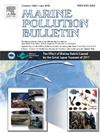Detecting the Phaeocystis globosa bloom and characterizing its bloom condition in the northern Beibu Gulf using MODIS measurements
IF 5.3
3区 环境科学与生态学
Q1 ENVIRONMENTAL SCIENCES
引用次数: 0
Abstract
Phaeocystis globosa is the most common species making up harmful algal blooms. For better detect P. globosa bloom, a multispectral approach was developed based on extensive in-situ investigation and MODIS remote sensing reflectance (Rrs) dataset. A novel proxy RPG was created based on the feature of Rrs spectral shape and P. globosa bloom was identified when RPG was >1.6. Normalized Fluorescence Line Height (nFLH) was applied to discriminate the bloom events and nFLH of bloom waters was almost higher than 0.095 Wm−2μm−1sr−1. The RPG associated with nFLH exhibited the P. globosa bloom areas comparable to that in field investigation, which indicated this practical method was successful on the spatial and temporal distribution of P. globosa blooms. Several environmental factors derived from MODIS products and field survey were analyzed to characterize the bloom conditions. Redundancy analysis suggested that nutrients and temperature are vital for triggering P. globosa bloom.
利用 MODIS 测量数据探测北部湾北部的球囊藻水华并描述其水华状况。
球囊藻是构成有害藻华的最常见物种。为了更好地检测球藻水华,在广泛的现场调查和 MODIS 遥感反射率(Rrs)数据集的基础上开发了一种多光谱方法。根据 Rrs 光谱形状特征创建了一种新的替代 RPG,当 RPG >1.6 时,就能识别出球藻花。应用归一化荧光线高(nFLH)来区分水华事件,水华水域的 nFLH 几乎高于 0.095 Wm-2μm-1sr-1。与 nFLH 相关的 RPG 所显示的球藻藻华区域与实地调查的区域相当,这表明这种实用的方法在球藻藻华的时空分布方面是成功的。分析了从 MODIS 产品和实地调查中得出的若干环境因素,以确定水华的特征。冗余分析表明,营养物质和温度对引发球藻藻华至关重要。
本文章由计算机程序翻译,如有差异,请以英文原文为准。
求助全文
约1分钟内获得全文
求助全文
来源期刊

Marine pollution bulletin
环境科学-海洋与淡水生物学
CiteScore
10.20
自引率
15.50%
发文量
1077
审稿时长
68 days
期刊介绍:
Marine Pollution Bulletin is concerned with the rational use of maritime and marine resources in estuaries, the seas and oceans, as well as with documenting marine pollution and introducing new forms of measurement and analysis. A wide range of topics are discussed as news, comment, reviews and research reports, not only on effluent disposal and pollution control, but also on the management, economic aspects and protection of the marine environment in general.
 求助内容:
求助内容: 应助结果提醒方式:
应助结果提醒方式:


